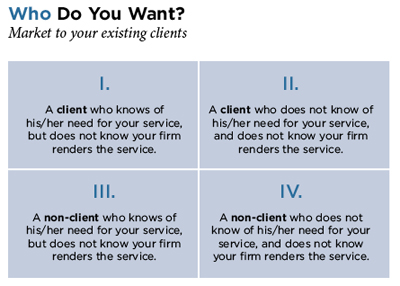As 2012 drew to a close, wealth management professionals were inundated with business from families waiting until the last minute to take advantage of the estate-planning opportunity of a lifetime. But now that the dust has settled, and we’re well into 2013, are you still just as busy or has the momentum fizzled? If you find yourself in the latter category, have you stopped to ask yourself some poignant questions as to why business has slowed, and what you can do about it? If you’re serious about growing your practice, then marketing should be top of mind in slower times. But the question remains – what is the best form of marketing to maximize your time and dollars?
When I speak to colleagues regarding their marketing strategies, the traditional answers I hear sound something like this:
“I attend various functions to meet prospective referral sources or clients.”
“I take potential referral sources to lunch.”
“I am immersed in various organizations where new business is generated.”
The traditional marketing strategy of many wealth advisors is to “sell” yourself to someone who has no experience working with you or your firm. When you step back and think about it; that sounds like paddling upstream against a very strong current!
I am by no means telling you to stop getting out and meeting people, but that should only be a portion of your marketing strategy. After attending a “networking function,” have you ever discarded a pile of business cards handed to you or kept them and noticed that months or even years later you could no longer even remember who those people were? In retrospect, has the revenue and the return on investment been sufficient to justify the time spent? And has the work generated been of the caliber you’d hoped?
Time Well Spent?
If any of this sounds all too familiar, you might ask yourself one critical question:
How much time do you spend marketing to those people who already know you, trust you and buy from you? In other words, how much time do you spend with clients, getting to know them better, finding out what is important to them and just hearing about their lives without billing them? You would do that for a new prospect! Those moments spent with a client are invaluable and will disclose planning opportunities where all of your services are needed.
Is your initial reaction to dismiss this concept with the statement, “But, my existing clients only come to me for….” and then to fill in that sentence with one or two select services within your practice? If so, you might want to step out of that box for a moment and take a look at “Who Do You Want?” “ below, which describes four types of potential clients.

In which quadrant do you think you can best maximize your marketing time and dollars? Hopefully, you said quadrant I, which is your existing client base.
Engaging Current Clients
If marketing to current clients is beginning to make sense to you, the next step is to decide how to best engage them. After all, you want to deepen these relationships; you don’t want to push them away with an overzealous “sales” approach.
I recently became a Chartered Advisor in Philanthropy (CAP), an experience which I believe has provided me with valuable insight in this area.
During the course, we were trained to ask our clients questions that look beyond their finances and instead delve into what they want on an emotional level, such as security for themselves and their families, a lasting legacy, to make a difference for a specific charity or whatever else might be important to them. Learning to view clients in this manner has helped build trust and deepen relationships in all areas of my practice.
For example, I recently met with a man whose child is nearing adult age, but has the intellectual capacity of a 7-year-old. Our goal for the meeting was simply to review his current life insurance policies. His primary mission was to ensure that his child would be provided for in the future, without financially punishing his other children. While this situation obviously had nothing to do with charitable giving, the skills I had learned during the CAP program were just as valuable. Rather than focusing merely on the “numbers,” I instead was able to create a strong bond with this man based on empathy. As a result, he viewed me not just as an insurance professional, but also as someone who emotionally understood his need to provide for his family when he was no longer around.
If this sounds “touchy-feely,” you’re right. But just as the medical profession is realizing that patients must be viewed holistically rather than as a conglomeration of unrelated parts, the same is true of wealth management. Your clients’ finances are related to every other aspect of their lives – and the issues surrounding them are often emotionally charged.
Marketing to existing clients isn’t really marketing at all: it’s about engaging more deeply with those who already know and trust us and educating them on how we can help them fulfill a variety of needs beyond what they are currently aware. When we take the time to find out what drives them as individuals, we can create a satisfying relationship for them and a thriving business for ourselves – a true win-win scenario.
So, the next time you think of spending an hour at a networking luncheon, how about picking up the phone and inviting a client to lunch just to discuss what’s going on in his life? Chances are you’ll gain great insight in that hour and will find that you can help them in more ways than you had previously imagined.
If you feel uncomfortable contacting a client out of nowhere and inviting him to lunch, then I suggest you look at your practice and identify an area in which you might be able to expand your services while fulfilling a need. As a CPA and a life insurance professional, I’ve found that focusing on life insurance as an asset class and offering to provide a review of my clients’ policies is an effective means to prompt a meeting. It also opens the door to a conversation about other aspects of their finances.
The reason I use a life insurance review as a stepping-stone to a broader financial conversation with my existing clients is simple: life insurance policies typically contain many issues that need to be resolved.
But while marketing via life insurance works the best for me, you might find that another area is more appropriate for your type of practice. The bottom line is that if you’re not marketing to your existing clients as a long-term strategy for growth and don’t have a legitimate “hook” to get them back in the door, you’re doing a disservice to both them and yourself.
Formulating Strategy
When formulating your marketing strategy, consider the following questions:
- What type of business do you want to have? The answer will be determined by your client relationships and your motivation to add value.
- Do you want your clients to simply view you as fulfilling their needs in one or two areas, or do you prefer to play a vital role in their overall financial health?
- Where would you rather spend your “marketing” time and money? The most effective effort is spent with people who already know and trust you.
If the traditional “networking meeting treadmill” isn’t providing the type of growth you had hoped for your business, it might be time to step off it for a while and invest your resources closer to home. Try spending the next couple of months reaching out to existing clients, engaging with them in an empathetic manner and educating them as to how you can provide them with tremendous added value. Doing so creates a scenario in which you are able to build your firm’s profitability, while your clients walk away from the project feeling great about the experience, the result and you – and that’s a true win-win.






